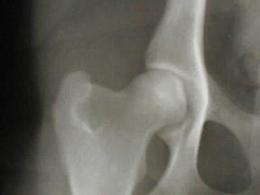|
' Hip Dysplasia'

Hip Dysplasia is a hereditary disease that affects the
hip joints of dogs. It is characterised by a looseness in the hip joint
that causes abnormal wear and tear on the femoral head (the ball part of this
ball and socket). The wear and tear leads to the malformation of the ball
and socket, and this can lead to arthritis. Dogs are born with normal hip
joints, and dogs affected by hip dysplasia show signs from 5-6 months of age
until maturity. The pain is generated by abnormal arthritic bones rubbing
against one another. Unfortunately arthritis will worsen with time, unless
surgery is administered.

Clinical Signs of Hip Dysplasia
Arthritis develops slowly and it can be a
considerable time before
you notice that it is affecting your dog.
Early Signs May Include:
* Hopping like a rabbit with the rear legs when
running
* Difficulty in rising from a sitting position
* Stiffness in the first few steps after lying down
* Reluctance to walk normal distances or play as
hard or as long as normal of dogs of the same age.
Exercise causes these signs to become more
prominent. It is important to remember that dogs
DO NOT USUALLY CRY IN PAIN.
Instead they do not use the joint or joints that
hurt. As the arthritis becomes more severe, dogs will be reluctant to play
or go on long walks and in extreme cases they may not want to walk at all.
Most dogs have both hips affected, and because of this your dog may not have an
obvious limp in one leg depending on if the pain is equal in both hips.
|
NORMAL HIP JOINT |
DYSPLASTIC HIP JOINT |
|
 |
 |
|
|
|
|
|
Diagnosis
Xrays are used routinely to diagnose dogs with hip dysplasia. In
Australia, the xray is performed under general anesthetic and is scored by AVA
(Australian Veterinary Association) or Pennhip.
Xrays will show changes prior to the onset of any clinical sings. Some
dogs may never have any clinical signs, but have severe changes seen on their
radiographs. The cost of the Xrays and having the Xray scored is between $200 -
$300.
Treatment and Prognosis
The primary treatment is surgery, with sometimes the addition of medical
treatment and acupuncture to alleviate arthritis pain. These treatments do
not correct the underlying cause of hip pain. There are a few different types of
surgery for dogs suffering from hip dysplasia which depends on age and if
arthritis is already present. The procedures are around 90% effective.
Once the proper surgical procedure is completed and the dog has recuperated, a
full range of activities can resume.
HIPS ARE SCORED ONCE IN
THE DOGS LIFETIME.

Music:
How Am I Supposed To Live Without You - Michael Bolten
© Braydnvale Cavaliers 2004

|